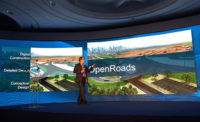The three-phase, 1-million-sq-ft Kaiser Permanente Oakland Medical Center features a 14-story, 349-bed hospital tower with an emergency department, 12 in-patient operating rooms, and eight labor-and-delivery rooms, among many other units. The supporting buildings include a specialty medical office building with operating rooms, a central utility plant and a 1,219-space parking garage.
Chris Pechacek says the contractor's technology toolbox for the project includes Tekla Structures' Construction Management module as the construction-document repository and Bluebeam PDF Revu for general markup and for setting up hyperlinked electronic documents, such as plans and specs.
The project is one of 10 in the industry that has been testing a beta version of BIManywhere—the just-launched mobile 3D-model file and data delivery service. Single-user accounts are priced from $20 to $250 per month, plus $20 for each additional user, in tiers of 30 megabytes, 250 mb and 600 mb of compressed files uploaded. A $10 app available from the Apple Store also is required.
The app lets users with an iPad or laptop scan a QR code to trigger a wireless communication with a BIManywhere server. The service's proprietary format delivers a 3D-model display of the space identified by the QR sticker. The gyroscopes in the tablet cause the model view to shift as the viewer turns the pad, and menu selections can overlay the view with laser scans of the space prior to wall cladding, intended equipment documentation and other project information.
"This is almost like giving you X-ray vision," says Philip Lorenzo, McCarthy project engineer. "We're working with our owner right now to see if they are interested in integrating this as a deliverable. It depends on how far our client wants to take it."
In the next version of BIMAnywhere, in addition to using QR codes, users also can navigate the model from a 2D PDF floor plan created with a BIManywhere plug-in using AutoCAD. When users tap on a location on the plan, it will present that spot in the model.
"This came from working out in the field and seeing how BIM is used—or not used—and the struggles of a lot of people who want to get this information but can't," says Peter Wu, a trained civil engineer, Zimfly principal and co-founder of the company with Winson Chu. "One of the biggest problems with 3D modeling in the industry is navigation," he says, explaining that Zimfly, which started out as a gaming company, uses a "very graphic-intensive" customized gaming engine for the product.
"It's not really magic," says Pechacek. "It takes a little bit of work to set up, but it reaches to a digital exchange server they have for this project."
Scan, Grind, Repeat
In one specific application of laser scanning to help manage a high-risk change order, McCarthy is using a FARO Focus 3D scanner it bought in November 2011 to verify as-built conditions of an operating room in which a change order now has McCarthy installing a 9-ton, traveling MRI machine that moves on an overhead rail to scan patients still anesthetized on the operating table. The technology was not available when the hospital was in design and the room was built, but now Kaiser Permanente wants it. To accommodate it, the MRI support steel has to be electrically isolated from the rest of the building steel. The floor-to-carrying-beam tolerances for distance, alignment and deflection are exacting.













